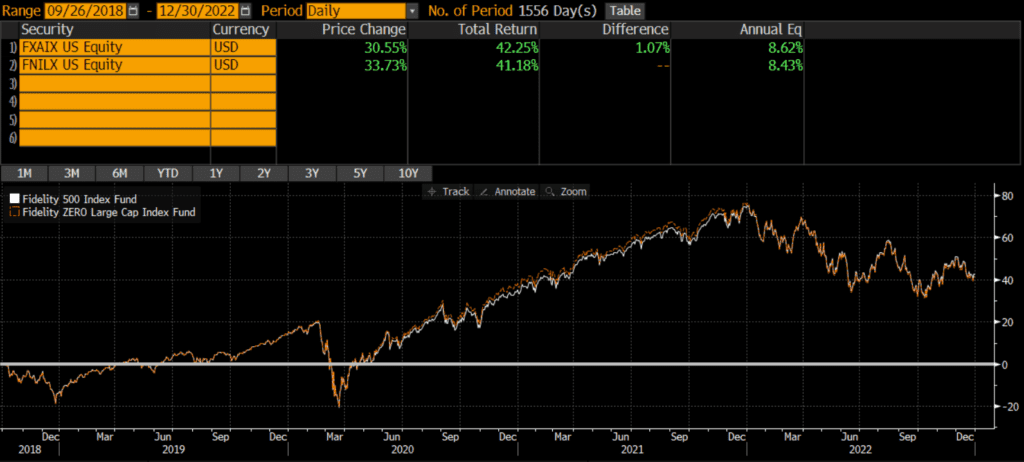The Fidelity 500 Index Fund (FXAIX) is one of the largest mutual funds in the world, with multiple share classes that go back decades. In 2018, Fidelity launched the ZERO Large Cap Index Fund (FNILX) which advertises a 0% expense ratio. Investors evaluating FXAIX vs FNILX will be hard-pressed to find many differences beyond the fact that FNILX can only be owned at Fidelity. The funds are nearly identical in every way, except for one major difference: FNILX cannot be bought or owned in non-Fidelity accounts.
A quick reminder that this site does NOT provide investment recommendations. Fund comparisons (such as this one) are not conducted to identify the “best” fund (since that will vary from investor to investor based on investor-specific factors). Rather, these fund comparison posts are designed to identify and distinguish between the fund details that matter versus the ones that don’t.
The Short Answer
There are very few differences between FXAIX and FNILX, except for the fact that FNILX cannot be bought or owned outside of Fidelity.
The underlying benchmark indices that these funds track are technically different (S&P 500 Index vs Fidelity U.S. Large Cap Index), but they are identical is most respects. Consequently, the risk and return of FXAIX and FNILX is nearly identical and I consider these two funds equivalent and interchangeable.
Historical Performance: FXAIX vs FNILX
FXAIX was launched in 1988, while FNILX was launched on September 13, 2018. Since that time, the fund’s have performed nearly identically: 8.62% vs 8.43% annualized. The cumulative performance difference over that time has only been about 1%.

Differences Between FXAIX and FNILX
As the above performance chart shows, the risk and return of the two funds is nearly identical. This is not surprising given the fund composition data below.
Geography
Both the FNILX and FXAIX only include stocks of US-domiciled companies.
Market Capitalization
The two funds have a quite a different number of holdings (as of 11/30/2022); FNILX holds 506 stocks versus FXAIX‘s 503 stocks. However, the market cap weighting of the funds are nearly identical.
| FNILX | FXAIX | |
| Large Cap | 84% | 83% |
| Mid Cap | 16% | 16% |
| Small Cap | 0% | 0% |
Sector Weights
The sector weights of each fund are nearly identical with most sector weights within 1% of the other fund.
| FNILX | FXAIX | |
| Basic Materials | 2.41% | 2.40% |
| Consumer Cyclical | 9.95% | 10.16% |
| Financial Services | 13.69% | 13.80% |
| Real Estate | 2.64% | 2.77% |
| Communication Services | 7.53% | 7.46% |
| Energy | 5.12% | 5.12% |
| Industrials | 8.48% | 8.86% |
| Technology | 24.76% | 23.72% |
| Consumer Defensive | 7.18% | 7.40% |
| Healthcare | 15.38% | 15.31% |
| Utilities | 2.86% | 2.99% |
Factors to Consider
Tradability
In my view, the most important factor to consider when evaluating FXAIX vs FNILX is the fact that FNILX cannot be bought or owned outside of Fidelity. Personally, this is a non-starter for me as there are reasons to transfer assets to other custodians, such as transferring one’s accounts or making a donation. Some investors may not value flexibility as much, but they should be aware of this limitation.
Expenses
FNILX grabbed headlines when Fidelity announced it, due to the 0% expense ratio. While zero expenses is great, it is only .015% less than FXAIX. So ever though the difference in expenses is infinite in relative terms, its only a basis point and a half difference. At a certain level (such as this one), differences in expense ratios do not matter.
Transaction Costs
ETFs are free to trade at many brokers and custodians, although many still charge commissions and/or transaction fees to buy/sell mutual funds. To my knowledge, Fidelity does not participate in the pay-to-play arrangements that would allow their mutual funds to trade for free on many platforms. So if an investor account is at Fidelity, it is free to trade FXAIX or FNILX. Outside of Fidelity, investors cannot trade FNILX and will have to pay to trade FXAIX.
Tax Efficiency & Capital Gain Distributions
Both FXAIX and FXROX routinely makes capital gains distributions, although they are relatively small owing to the fact that they are both index funds. Taxable investors may want to consider ETFs which are generally more tax-efficient and can read our reviews of FXAIX vs VOO or FXAIX vs SPY.
Final Thoughts on FXAIX & FNILX
These two funds are nearly identical, except for the fact that FNILX can only be bought and owned at Fidelity. As mentioned above, I view this a severe limitation and would not consider FNILX for my personal portfolio.